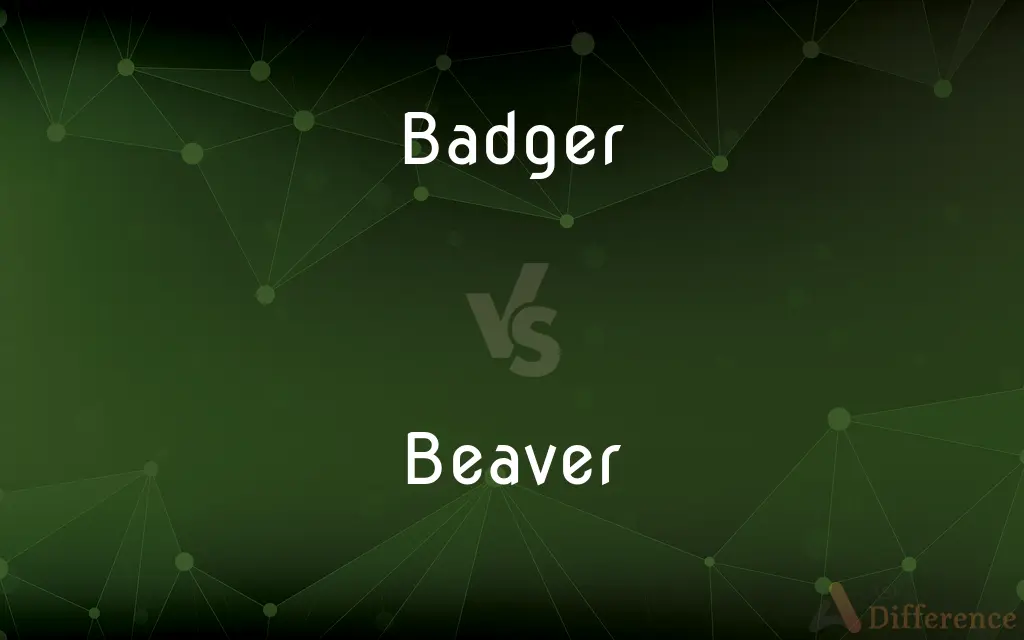Badger vs. Beaver — What's the Difference?
By Maham Liaqat & Urooj Arif — Updated on March 11, 2024
Badgers are primarily carnivorous, known for their digging abilities and aggressive defense tactics, while beavers are herbivorous. Badgers have a broader diet and live in burrows, contrasting with beavers’ aquatic constructions and plant-based diet.

Difference Between Badger and Beaver
Table of Contents
ADVERTISEMENT
Key Differences
Badgers are known for their stocky bodies, powerful limbs, and sharp claws, making them excellent diggers. They typically live in burrows called setts, which can be extensive networks underground. On the other hand, beavers are recognized for their flat tails, used for swimming and signaling danger, and their strong teeth for cutting trees. Beavers construct dams and lodges, creating aquatic habitats that benefit a wide range of species.
While badgers have a varied diet that includes insects, small mammals, and occasionally fruits and plants, beavers strictly adhere to a plant-based diet. This includes tree bark, aquatic plants, and leaves. Whereas badgers' omnivorous diet reflects their adaptability to different environments, beavers' feeding habits directly impact their surrounding ecosystems, often leading to significant environmental modifications.
Badgers are solitary or live in small family groups, with social structures varying among species. They are territorial and can display aggressive behavior when threatened. Beavers, however, are highly social animals, living in family groups called colonies. Their cooperative behavior is essential for the construction and maintenance of dams and lodges, showcasing a strong social structure centered around family units.
In terms of habitat, badgers are more adaptable and can be found in a variety of environments, including woodlands, grasslands, and even suburban areas. This adaptability contrasts with beavers, which are strictly aquatic and depend on water bodies to support their way of living. Beavers' ability to transform their environment to suit their needs is unmatched among mammals, illustrating their ecological significance.
The interaction of badgers and beavers with humans also differs. Badgers, due to their burrowing, can sometimes conflict with agricultural and developmental interests, while beavers, through their dam-building, can cause flooding but also create wetlands that support biodiversity. Both species have faced population pressures from habitat destruction and hunting but play crucial roles in their respective ecosystems.
ADVERTISEMENT
Comparison Chart
Diet
Omnivorous, including insects, small mammals, and plants.
Herbivorous, mainly tree bark and aquatic plants.
Habitat
Burrows in a variety of environments including woodlands and grasslands.
Aquatic habitats, building dams and lodges in waterways.
Social Structure
Solitary or small family groups, varies by species.
Highly social, living in family groups called colonies.
Construction
Digging extensive networks of burrows.
Building dams and lodges in water bodies.
Interaction with Environment
Adaptable to diverse environments but can conflict with human activities.
Transform environments by creating wetlands, can cause flooding but also support biodiversity.
Tail
Short and bushy.
Large, flat, and used for swimming and signaling.
Defense Mechanism
Aggressive when threatened, use claws and teeth.
Use waterways and lodges for protection.
Compare with Definitions
Badger
A carnivorous mammal known for digging extensive burrows.
The badger used its sharp claws to excavate a sett.
Beaver
A herbivorous mammal famous for building dams and lodges.
The beaver used branches to construct its dam.
Badger
Omnivorous, feeding on a variety of food sources.
Badgers can adapt their diet to include insects, worms, and small mammals.
Beaver
Lives in family groups called colonies.
The beaver colony worked together to repair the lodge.
Badger
Solitary or living in small family groups.
A family of badgers was spotted near the woodland burrow.
Beaver
Creates aquatic habitats that support biodiversity.
The beaver dam created a wetland that attracted various bird species.
Badger
Characterized by its stocky build and aggressive nature.
The badger defended its territory fiercely against intruders.
Beaver
Has a distinctive flat tail used for swimming and signaling.
The beaver slapped its tail on the water as a danger signal.
Badger
Adaptable to various habitats.
Badgers are found in both rural and suburban areas, adjusting well to different environments.
Beaver
Strictly plant-based diet, including tree bark and leaves.
Beavers are crucial for maintaining healthy forests by controlling tree growth.
Badger
Badgers are short-legged omnivores mostly in the family Mustelidae (which also includes the otters, polecats, weasels, and ferrets), but also with two species called "badgers" in the related family Mephitidae (which also includes the skunks). Badgers are a polyphyletic grouping, and are not a natural taxonomic grouping: badgers are united by their squat bodies, adapted for fossorial activity.
Beaver
Beavers are large, semiaquatic rodents in the genus Castor native to the temperate Northern Hemisphere. There are two extant species: the North American beaver (Castor canadensis) and the Eurasian beaver (C. fiber).
Badger
Any of several carnivorous burrowing mammals of the family Mustelidae, such as Meles meles of Eurasia or Taxidea taxus of North America, having short legs, long claws on the front feet, and a heavy grizzled coat.
Beaver
Either of two large semiaquatic rodents, Castor canadensis of North America or C. fiber of Eurasia, having thick brown fur, webbed hind feet, a broad flat tail, and sharp incisors used for gnawing bark and felling trees, with which they construct dams and underwater lodges.
Badger
The fur or hair of any of these mammals.
Beaver
The fur of a beaver.
Badger
Any of several similar mammals, such as the ratel.
Beaver
A top hat originally made of the underfur of a beaver.
Badger
To ask or nag (someone) about something in an annoying and persistent way; pester
Badgered the boy into cleaning his room.
Beaver
A napped wool fabric, similar to felt, used for outer garments.
Badger
Any mammal of three subfamilies, which belong to the family Mustelidae: Melinae (Eurasian badgers), Mellivorinae (ratel or honey badger), and Taxideinae (American badger).
Beaver
Vulgar Slang The female genitals.
Badger
A native or resident of the American state, Wisconsin.
Beaver
Offensive Slang A woman or girl.
Badger
(obsolete) A brush made of badger hair.
Beaver
A piece of armor attached to a helmet or breastplate to protect the throat or lower face.
Badger
A crew of desperate villains who robbed near rivers, into which they threw the bodies of those they murdered.
Beaver
The visor on a helmet.
Badger
(obsolete) An itinerant licensed dealer in commodities used for food; a hawker; a huckster; -- formerly applied especially to one who bought grain in one place and sold it in another.
Beaver
Of or relating to a beaver or beavers
Beaver fur.
A beaver hat.
Badger
To pester; to annoy persistently; to press.
He kept badgering her about her bad habits.
Beaver
Constructed by beavers
Beaver dams.
Badger
An itinerant licensed dealer in commodities used for food; a hawker; a huckster; - formerly applied especially to one who bought grain in one place and sold it in another.
Beaver
To work diligently and energetically.
Badger
A carnivorous quadruped of the genus Meles or of an allied genus. It is a burrowing animal, with short, thick legs, and long claws on the fore feet. One species (Meles meles or Meles vulgaris), called also brock, inhabits the north of Europe and Asia; another species (Taxidea taxus or Taxidea Americana or Taxidea Labradorica) inhabits the northern parts of North America. See Teledu.
Beaver
To spot a beard in a game of beaver.
Badger
A brush made of badgers' hair, used by artists.
Beaver
To work hard.
Badger
To tease or annoy, as a badger when baited; to worry or irritate persistently.
Beaver
To cut a continuous ring around a tree that one is felling.
Badger
To beat down; to cheapen; to barter; to bargain.
Beaver
(backgammon) After being doubled, to immediately double the stakes again, a move that keeps the doubling cube on one’s own side of the board.
Badger
Sturdy carnivorous burrowing mammal with strong claws widely distributed in the northern hemisphere
Beaver
(countable) A semiaquatic rodent of the genus Castor, having a wide, flat tail and webbed feet.
Badger
Annoy persistently;
The children teased the boy because of his stammer
Beaver
The fur of the beaver.
Badger
Persuade through constant efforts
Beaver
(countable) A hat, of various shapes, made from a felted beaver fur (or later of silk), fashionable in Europe between 1550 and 1850.
Beaver
(North American) Beaver pelts as an article of exchange or as a standard of value.
Beaver
Beaver cloth, a heavy felted woollen cloth, used chiefly for making overcoats.
Beaver
A brown colour, like that of a beaver.
Beaver
A move in response to being doubled, in which one immediately doubles the stakes again, keeping the doubling cube on one’s own side of the board.
Beaver
Senseid|en|member of the youngest wing of the Scout movement}} {{alternative case form of Beaver.
Beaver
Senseid|en|part of a helmet}} {{alternative spelling of bevor.
Beaver
An amphibious rodent, of the genus Castor.
Beaver
The fur of the beaver.
Beaver
A hat, formerly made of the fur of the beaver, but now usually of silk.
A brown beaver slouched over his eyes.
Beaver
Beaver cloth, a heavy felted woolen cloth, used chiefly for making overcoats.
Beaver
A man's beard.
Beaver
The hair on a woman's pubic area; - vulgar.
Beaver
A woman; - vulgar and offensive.
Beaver
A person who works enthusiastically and diligently; - used especially in the phrase eager beaver.
Beaver
That piece of armor which protected the lower part of the face, whether forming a part of the helmet or fixed to the breastplate. It was so constructed (with joints or otherwise) that the wearer could raise or lower it to eat and drink.
Beaver
The soft brown fur of the beaver
Beaver
A full beard
Beaver
A man's hat with a tall crown; usually covered with beaver or silk
Beaver
A movable piece of armor on a medieval helmet used to protect the lower face
Beaver
A hat made of beaver fur or similar material
Beaver
Large semiaquatic rodent with webbed hind feet and a broad flat tail; construct complex dams and underwater lodges
Beaver
Work hard on something
Common Curiosities
What distinguishes a badger from a beaver?
Badgers are omnivorous, known for their burrowing, while beavers are herbivorous, recognized for dam and lodge construction.
Do badgers and beavers have similar diets?
No, badgers have an omnivorous diet, whereas beavers are strictly herbivorous.
Are beavers social animals?
Yes, beavers live in highly social family groups called colonies and cooperate in building and maintaining dams.
What role does the beaver’s tail play?
The beaver’s flat tail aids in swimming and is used to signal danger.
How do badgers and beavers affect their environment?
Badgers adapt to their environment and can conflict with human activities, while beavers actively modify theirs, creating wetlands that support biodiversity.
Can badgers live in urban areas?
Yes, badgers can adapt to a variety of environments, including suburban and urban areas.
Are beavers effective in water conservation?
Yes, beavers play a crucial role in water conservation and management by creating wetlands that store and purify water.
Do badgers hibernate?
Badgers do not hibernate but may be less active during extreme cold weather.
How do badgers and beavers interact with humans?
Both can impact human activities—badgers through burrowing and beavers by dam-building, though beavers also contribute positively by creating biodiversity-supporting wetlands.
How do badgers defend themselves?
Badgers use their sharp claws and teeth and can be quite aggressive when threatened.
How do beaver dams benefit other species?
Beaver dams create habitats that support a wide range of wildlife, including fish, birds, and amphibians.
What challenges do badgers face?
Badgers face challenges from habitat loss, persecution, and road mortality.
Can the presence of beavers lead to conflicts with humans?
Yes, while beavers can enhance ecosystem health, their dam-building can sometimes lead to conflicts due to flooding and tree loss.
What is the impact of beaver dams?
Beaver dams can cause flooding but also create valuable wetlands that support diverse ecosystems.
How do beavers choose a location for their dam?
Beavers select locations based on the availability of suitable trees and water flow that can support a stable dam and lodge.
Share Your Discovery

Previous Comparison
Inland vs. Coastal
Next Comparison
Peninsula vs. PeninsularAuthor Spotlight
Written by
Maham LiaqatCo-written by
Urooj ArifUrooj is a skilled content writer at Ask Difference, known for her exceptional ability to simplify complex topics into engaging and informative content. With a passion for research and a flair for clear, concise writing, she consistently delivers articles that resonate with our diverse audience.















































